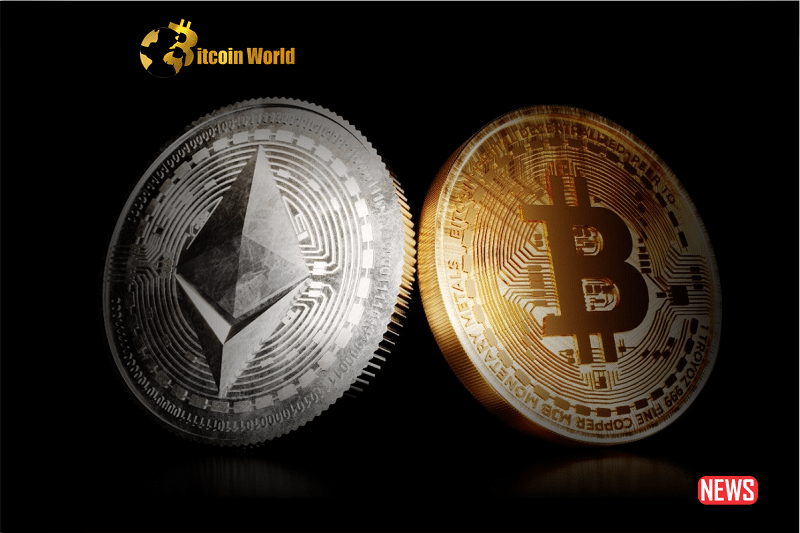Ever heard the saying, “as good as gold”? Well, the world of cryptocurrency is buzzing with a similar concept. BlackRock CEO Larry Fink recently sparked a fascinating discussion by suggesting Bitcoin could be seen as an international asset, a sort of “digital gold” on the blockchain. This got everyone thinking: if Bitcoin is the digital gold, what does that make other cryptocurrencies? Specifically, could Ethereum be the digital silver to Bitcoin’s gold?
Bitcoin and Ethereum: The Gold and Silver of Crypto?
The idea of Bitcoin as digital gold isn’t new, but Fink’s endorsement adds significant weight to the argument. Think about it: gold is a store of value, a hedge against inflation, and globally recognized. Bitcoin shares some of these characteristics. And if Bitcoin is digital gold, then Ethereum, with its impressive growth over the last seven years, naturally steps into the role of “Digital Silver.” But why Ethereum, and not others?
Why Not Litecoin? The Digital Silver Debate
You might be thinking, “Didn’t people used to call Litecoin the digital silver?” You’re right! Early on, Litecoin was often compared to Bitcoin due to its similar technical design. However, while Litecoin has its merits, Ethereum has undeniably taken the lead as Bitcoin’s most prominent counterpart. Its performance and the sheer innovation happening on its network have solidified its position.
Supply Matters: The Case for Litecoin and Ethereum
One area where Litecoin still holds a strong comparison to Bitcoin is in its supply mechanism. Like Bitcoin, Litecoin has a capped maximum supply and undergoes “halving” events, which reduce the rate at which new coins are created. This scarcity is a key part of the “digital gold/silver” narrative. Ethereum, on the other hand, historically didn’t have a fixed supply, leading to concerns about potential inflation. Let’s break this down:
- Bitcoin & Litecoin: Fixed maximum supply, halving events create scarcity.
- Ethereum (Historically): No fixed maximum supply, raising inflation concerns.
The Ethereum Burn: A Game Changer?
But here’s where things get interesting. Ethereum has implemented a mechanism known as the “ETH burn.” This process permanently removes a portion of ETH from circulation with each transaction. What’s the impact? According to data from Ultrasound Money, the combination of the ETH burn and the rate at which new ETH is issued is actually decreasing the overall supply of ETH by about 0.33% per year. This is a significant development, directly addressing those previous inflation worries and strengthening Ethereum’s claim as digital silver!
Bitcoin vs. Ethereum: Different Tools for Different Jobs
The debate about which cryptocurrency is “better” is a hot topic, especially on social media. But perhaps the better way to look at it is that Bitcoin and Ethereum have evolved to serve distinct, though sometimes overlapping, purposes.
Bitcoin: The Original and the Standard
Think of Bitcoin as the pioneer. It’s been around the longest and enjoys widespread recognition as the original decentralized digital currency. Its primary function is as a store of value and a medium of exchange.
Ethereum: The Innovation Hub
Ethereum, on the other hand, has become the driving force behind decentralized finance (DeFi). Its smart contract functionality allows developers to build a wide range of financial applications, cutting out traditional intermediaries. Imagine being able to lend, borrow, or trade assets directly with others, without needing a bank – that’s the power of DeFi on Ethereum.
| Feature | Bitcoin | Ethereum |
|---|---|---|
| Primary Function | Store of Value, Digital Currency | Platform for Decentralized Applications (DApps) and DeFi |
| Key Technology | Blockchain | Blockchain with Smart Contracts |
| Supply Mechanism | Fixed, Halving Events | Dynamic, ETH Burn Mechanism |
| Use Cases | Digital Gold, Inflation Hedge, Payments | DeFi, NFTs, DApps, Smart Contracts |
The Future of Digital Assets: Gold and Silver Coexisting?
So, where does this leave us? Larry Fink’s comments have reignited the conversation about Bitcoin’s role as digital gold. And as Ethereum continues to innovate and its supply dynamics evolve, its position as the leading contender for “digital silver” becomes increasingly compelling. While Bitcoin established the foundation for decentralized digital currency, Ethereum has expanded the possibilities with its smart contract capabilities.
Key Takeaway: Think of Bitcoin and Ethereum not as competitors, but as complementary assets in the digital landscape. Bitcoin offers a secure and established store of value, while Ethereum provides the infrastructure for a new wave of decentralized applications and financial services.
Ultimately, the cryptocurrency market is dynamic and ever-changing. The roles of Bitcoin and Ethereum may continue to evolve. But for now, the analogy of digital gold and silver provides a useful framework for understanding their distinct strengths and contributions to the burgeoning world of digital assets.
Disclaimer: The information provided is not trading advice, Bitcoinworld.co.in holds no liability for any investments made based on the information provided on this page. We strongly recommend independent research and/or consultation with a qualified professional before making any investment decisions.


